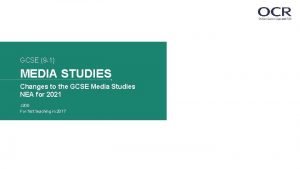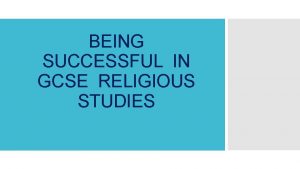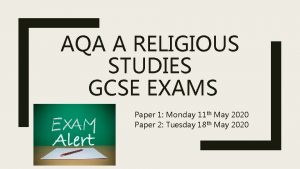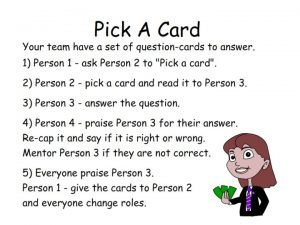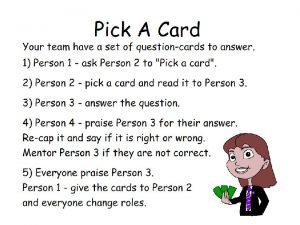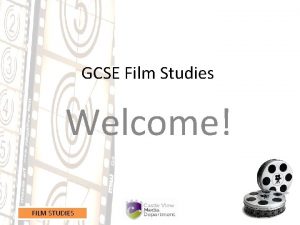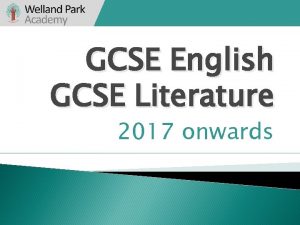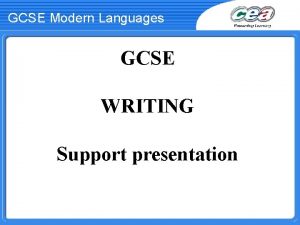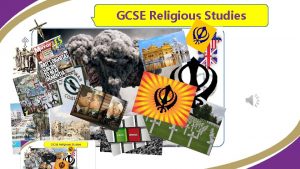GCSE 9 1 MEDIA STUDIES Changes to the















- Slides: 15

GCSE (9 -1) MEDIA STUDIES Changes to the GCSE Media Studies NEA for 2021 J 200 For first teaching in 2017

Changes to assessments for 2021 Ofqual have confirmed that students sitting GCSE Media Studies in 2021 can submit a prototype and supporting evidence for the NEA component if they are not able to submit a completed media product. There are no changes to the exam components. GCSE Media Studies J 200 © OCR 2020

Changes to the NEA for 2021 • Students can still submit completed NEA products. • If they can’t submit a completed product a prototype and supporting evidence may be submitted. • There are no changes to the mark scheme or NEA briefs. • The limits on the use of found materials stated in the NEA briefs apply to prototypes/mock-ups. Additional non-original materials can be used in any supporting evidence submitted. • Where possible we’d encourage students to use original footage, images, text and audio in their prototypes. • A Statement of Intent must be submitted. GCSE Media Studies J 200 © OCR 2020

Prototypes and supporting evidence submitted by students should: • show a full production would meet the requirements of the brief and production detail • reflect the required production lengths stated in the NEA briefs • allow students to demonstrate their knowledge and understanding of the media theoretical framework GCSE Media Studies J 200 © OCR 2020

Prototypes could be partially realised products – where students have been able to complete some production work (filming, photography) this can form the basis of their prototype, with the use of other materials, placeholders and supporting evidence to demonstrate their intentions for a full product. If students have not been able to complete any significant production work they can instead submit suitable planning documents or mock-ups as specified by OCR as a prototype. GCSE Media Studies J 200 © OCR 2020

Supporting Evidence If students submit prototypes rather than completed productions we strongly recommend they also provide supporting evidence to demonstrate their intentions for a full production and their application of knowledge and understanding of the media theoretical framework. A Statement of Intent must also be submitted. Supporting evidence should help students to demonstrate how a completed production would meet the requirements of the brief/production detail and show their application of understanding of the key areas of theoretical framework (media language, representation, audience). We have provided suggestions of evidence students may provide for each brief. Students can submit any other suitable forms of supporting evidence. GCSE Media Studies J 200 © OCR 2020

GCSE Media Studies – Prototypes GCSE Media Studies J 200 © OCR 2020

GCSE Media Studies – Brief 1: Magazines Brief 1 Magazines: a front cover and a double-page spread article for a fashion magazine. Prototypes • a prototype for the required magazine front cover and double page spread that may take the form of a partially completed product which indicates intentions for a full production or • a mock-up of the front cover and double page spread that demonstrates use or intended use of images, text, layout, colour, and typography and intentions for a full production Supporting evidence may include: • draft copy • draft layouts • original/non-original images • annotated drawings/sketches • a pitch • sample font styles/colour schemes The prototype should contain some original photography and text. GCSE Media Studies J 200 © OCR 2020

GCSE Media Studies – Brief 2: Television Brief 2 Television: two minutes of opening scenes including a title sequence for a television comedy. Prototypes • a rough cut for a two minute television sequence. This should include some original filmed footage and may also include music, audio effects, graphics, titles, original images, storyboard frames and/or other placeholders or • an annotated shooting script and storyboard for a two minute television sequence. It is recommended that the storyboard includes some original images GCSE Media Studies J 200 Supporting evidence may include: • scripts • shot lists • annotated storyboards • original/non-original photographs • annotated drawings/sketches • a pitch • casting considerations • location reports © OCR 2020

GCSE Media Studies – Brief 3: Music Video Brief 3 Music Video: a two minute sequence from a music video for a hip hop track. Prototypes • a rough cut for a two minute music video. This should include some original filmed footage and may also include graphics, original images, storyboard frames and/or other placeholders or • an annotated shooting script and storyboards for a two minute music video. It is recommended that the storyboard includes some original images GCSE Media Studies J 200 Supporting evidence may include: • scripts • shot lists • annotated storyboards • original/non-original photographs • annotated drawings/sketches • a pitch • casting considerations • location reports © OCR 2020

GCSE Media Studies – Brief 4: Online, Social and Participatory Brief 4 Online, Social/Participatory: viral ecological awareness campaign to include at least three social media posts. Prototypes • prototypes for at least three social media posts which demonstrate use or intended use of images, audio/video text, interactive features, layout, typography, and colour. The required 45 seconds of original audio/audiovisual content may be submitted as a script, storyboard or animatic. Supporting evidence may include: • draft copy • draft layouts • original/non-original images • annotated drawings/sketches • a pitch • sample font styles/colour schemes The prototype should contain some original photography and text. GCSE Media Studies J 200 © OCR 2020

Assessment of prototypes There are no changes to the mark scheme for assessment of prototypes and supporting evidence. • • Media language techniques (including use of conventions and communication of meaning) Audiences – use of content/audience address, creating meaning for intended audience Representations – construction of representations to create insights into the portrayal of events/issues/individuals/social groups Realisation of the brief – meeting requirements of the brief and production detail GCSE Media Studies J 200 © OCR 2020

Support for 2021 • Changes to Media Studies Assessment in 2021 video • Your Guide to the Changes to 2021 document • How to assess prototypes and supporting evidence Coming soon • Example NEA cover sheets for prototype submissions GCSE Media Studies J 200 © OCR 2020

Further Support Email: media@ocr. org. uk Call: 01223 553998 Follow and tweet: @OCR_Media_Film Sign up for email updates: https: //www. ocr. org. uk/qualifications/email-updates/ CPD: https: //www. ocr. org. uk/qualifications/professional-development/ GCSE Media Studies J 200 © OCR 2020

We’d like to know your view on the resources we produce. Click ‘ Like’ or ‘Dislike’ to send us an auto generated email about this resource. Add comments if you want to. Let us know how we can improve this resource or what else you need. Your email will not be used or shared for any marketing purposes. Looking for another resource? There is now a quick and easy search tool to help find free resources for your qualification. OCR provides resources to help you deliver our qualifications. These resources do not represent any particular teaching method we expect you to use. We update our resources regularly and aim to make sure content is accurate but please check the OCR website so that you have the most up to date version. OCR cannot be held responsible for any errors or omissions in these resources. Though we make every effort to check our resources, there may be contradictions between published support and the specification, so it is important that you always use information in the latest specification. We indicate any specification changes within the document itself, change the version number and provide a summary of the changes. If you do notice a discrepancy between the specification and a resource, please contact us. © OCR 2020 You can copy and distribute this resource freely if you keep the OCR logo and this small print intact and you acknowledge OCR as the originator of the resource. OCR acknowledges the use of the following content: Whether you already offer OCR qualifications, are new to OCR or are thinking about switching, you can request more information using our Expression of Interest form. Please get in touch if you want to discuss the accessibility of resources we offer to support you in delivering our qualifications.
 Eduqas media studies gcse
Eduqas media studies gcse Media studies gcse past papers
Media studies gcse past papers Unit 1: media representations mark scheme
Unit 1: media representations mark scheme Elizabeth mulroney
Elizabeth mulroney Physical change chemistry
Physical change chemistry Pixl knowit gcse chemistry quantitative
Pixl knowit gcse chemistry quantitative Eduqas rs gcse past papers
Eduqas rs gcse past papers Aqa rs gcse past papers
Aqa rs gcse past papers Ocr business studies gcse past papers
Ocr business studies gcse past papers Gcse geography manchester case study
Gcse geography manchester case study Gcse business studies resources
Gcse business studies resources Ccea gce business studies
Ccea gce business studies Ocr j276/01
Ocr j276/01 Business studies definitions
Business studies definitions Margin of safety gcse
Margin of safety gcse Business studies unit 1
Business studies unit 1


